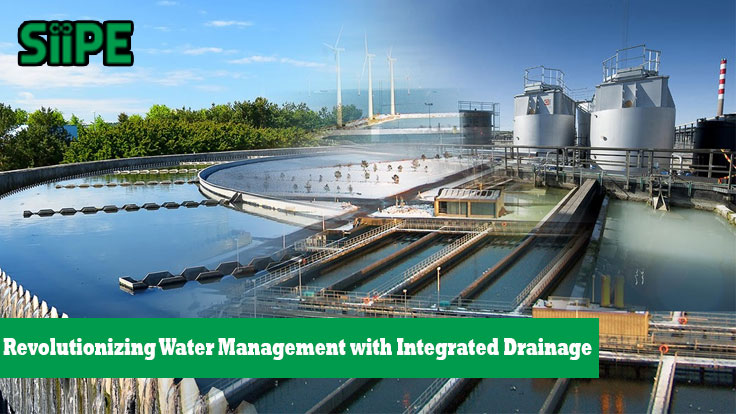When we think about drainage, we usually imagine a bunch of pipes and drains designed to carry away rainwater or waste. But today’s drainage systems are way more advanced than just a simple network of pipes. Enter the Integrated Drainage System (IDS). This modern approach combines several methods and technologies to manage water in smarter, more sustainable ways. So, what exactly is an integrated drainage system, and why is it becoming more popular in urban planning? Let’s dive into it.
What Is an Integrated Drainage System?
At its core, an Integrated Drainage System (IDS) is a way of managing both stormwater and wastewater by integrating them into one cohesive system. In the past, cities often had two separate systems: one to handle rainwater and another for sewage or wastewater. But with an IDS, everything is combined in a more coordinated way to deal with water more efficiently.
The main goal of an IDS is to manage water runoff, avoid flooding, and reduce pollution—all in a way that’s sustainable and in harmony with the environment. This could mean using natural elements like ponds or green spaces, advanced technology, and smart design to manage water. Instead of water just being channeled away, it’s managed in ways that benefit the local environment and urban areas.
Why Is an Integrated Drainage System Important?
So, why are integrated drainage systems such a big deal, especially in cities? Well, there are a few key reasons:
Flood Prevention
Urban areas, with all their concrete roads and buildings, don’t have much space for rainwater to soak into the ground. This leads to more surface runoff, which can overwhelm traditional drainage systems and cause flooding. An IDS manages runoff more efficiently by spreading water across different areas like green roofs, wetlands, or even underground storage. By integrating various drainage techniques, the system can handle more water and reduce the risk of flooding.
Water Quality Improvement
An IDS doesn’t just move water from one place to another; it also ensures that the water is cleaner. Rainwater can carry pollutants like oils, chemicals, and trash from roads into water systems. But with an integrated system, the water can be treated before it’s released into rivers or oceans. This helps to improve water quality and reduce pollution, benefiting both the environment and local communities.
Sustainability and Ecosystem Health
One of the main advantages of an IDS is that it’s designed to work with nature, not against it. By incorporating natural elements like vegetation, wetlands, or porous pavements, these systems help maintain local ecosystems. For example, rainwater can be directed into rain gardens or permeable surfaces where plants can filter and absorb it, providing habitat for wildlife while also reducing the burden on traditional stormwater systems.
Efficient Use of Space
In crowded urban areas, space is a precious commodity. An integrated drainage system can be designed to maximize available space while still managing water effectively. Instead of relying solely on large, unsightly pipes, the system can use underground storage or multi-purpose areas like green parks that double as drainage basins. This makes urban spaces more livable and functional.
How Does an Integrated Drainage System Work?
Now that we know why integrated drainage systems are important, let’s take a closer look at how they actually work. There are several components that come together to make an IDS function effectively:
Surface Water Management
This involves the collection and redirection of stormwater (rainwater) to prevent flooding. In an IDS, surface water can be channeled into swales, ponds, or wetlands where it can be stored or filtered before being slowly released into the environment. These methods help reduce the volume and speed of runoff, which can prevent soil erosion and reduce the stress on local drainage systems.
Sustainable Urban Drainage Systems (SUDS)
These are techniques used in an IDS to manage water in ways that benefit the environment. SUDS include things like permeable pavements (where rainwater can soak through the surface), green roofs (which absorb rainwater), and rain gardens (planted areas that filter and store rainwater). SUDS reduce the amount of water that runs off into traditional drains, helping to minimize flooding and pollution.
Underground Storage
In areas with limited space, IDS often incorporates underground storage systems to hold excess rainwater. These underground tanks or reservoirs collect water during heavy rain and release it slowly into the drainage system over time. This helps to prevent overwhelming the system and flooding the area.
Water Treatment
Before the rainwater or runoff is sent back into rivers, lakes, or oceans, it can be treated to remove pollutants. For example, sediment traps, oil separators, or biofiltration systems can be used to clean the water. By integrating water treatment into the drainage system, an IDS ensures that the water released back into nature is as clean as possible.
Smart Technology
Modern IDS are often equipped with sensors and monitoring systems that allow real-time management of water flow. This means that if a storm is on the way or water levels are rising, the system can automatically adjust to accommodate the extra water. Smart technology ensures that the system is responsive and can prevent problems before they happen.
Benefits of Integrated Drainage Systems
Flood Control
One of the biggest benefits of IDS is its ability to manage and reduce the risk of flooding, especially in cities where heavy rainfall can overwhelm the system. By controlling the flow of water and using green spaces to absorb it, IDS helps prevent flooding that could damage property, infrastructure, and the environment.
Environmental Benefits
Since an IDS helps clean water before it’s released back into the environment, it can significantly reduce pollution. Plus, using natural drainage methods like green roofs and rain gardens helps maintain biodiversity and creates more green spaces in cities, which are great for the environment and residents alike.
Cost-Effective
While the upfront cost of implementing an integrated drainage system might seem high, in the long run, it can save cities and communities money. By reducing flood damage, improving water quality, and preventing costly infrastructure repairs, an IDS can be a smart investment.
Enhanced Quality of Life
Integrating drainage systems with green spaces and natural elements helps create more attractive, livable urban environments. Parks, gardens, and tree-lined streets don’t just make a city prettier; they also improve air quality, reduce heat islands, and provide spaces for recreation and relaxation.
Challenges of Implementing Integrated Drainage Systems
While IDS offers many benefits, there are some challenges in implementing them:
- Cost and Initial Investment
Building an IDS often requires significant upfront investment in infrastructure, especially in areas that already have existing drainage systems. While the long-term savings are clear, the initial costs can be a barrier. - Maintenance
While IDS are designed to be sustainable, they still require regular maintenance. Green spaces need care, and monitoring systems need to be updated to ensure they’re functioning properly. - Space Limitations
In highly urbanized areas, finding space for natural drainage solutions like green roofs or rain gardens can be difficult. Creative design solutions are needed to make room for these elements while still maintaining functionality.
An Important Part of Planning
Integrated Drainage Systems are transforming the way we manage water in urban environments. By combining traditional drainage with sustainable and natural solutions, IDS offers a smarter, greener way to handle stormwater and wastewater. Not only do they help prevent flooding and improve water quality, but they also create more livable, attractive spaces in cities. While there are challenges to overcome, the long-term benefits of IDS are clear—making them an essential part of future urban planning.








